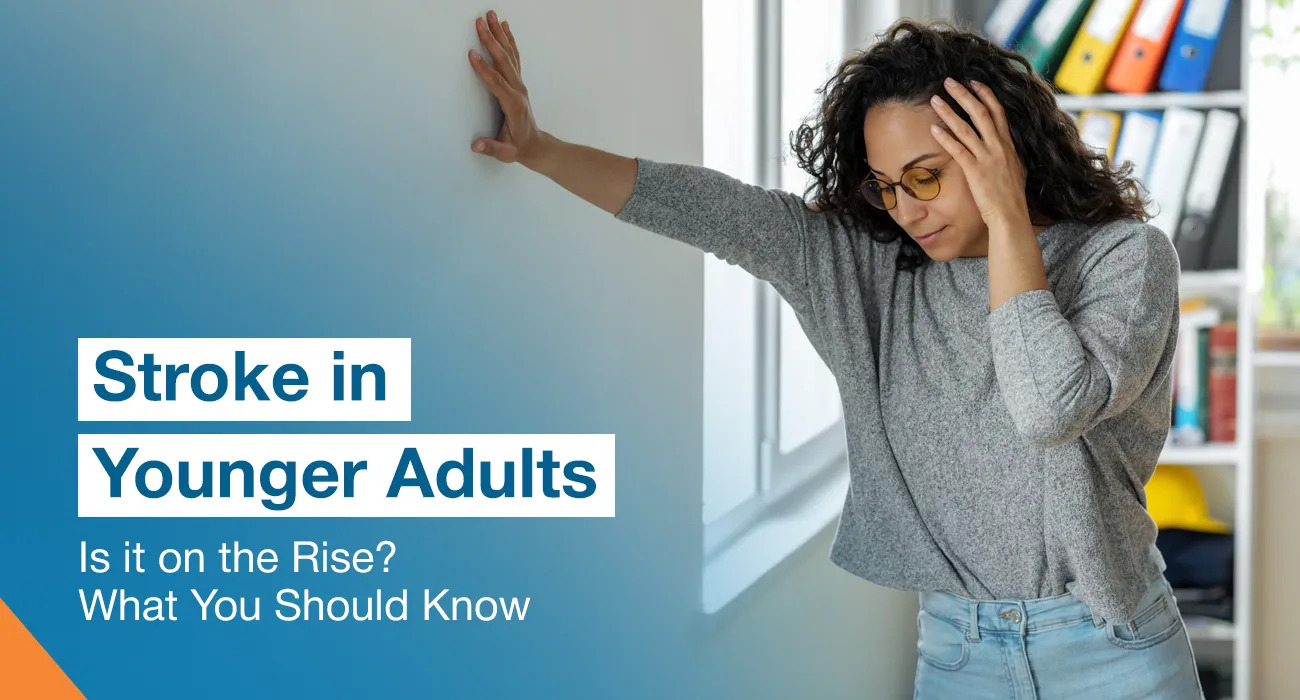Stroke in Younger Adults: Is It on the Rise? What You Should Know
10/13/2025
Stroke is the second leading cause of death globally after cardiovascular diseases and is recognized as the leading reason behind long-term physical and cognitive disability in adults. Strokes occur when a blood clot or broken vessel stops or interrupts the blood from getting to your brain.
You can recognize the symptoms of stroke with the help of the acronym: BE FAST (the quick way to identify early warning signs of stroke in younger adults)
- B - Balance: Sudden trouble walking or loss of coordination.
- E - Eyes: Sudden blurred vision, double vision in one or both eyes.
- F - Face: One-sided facial drooping when the person smiles.
- A - Arms: Problem in lifting arms; one arm drifts downward when lifted.
- S - Speech: Slurred speech or unable to understand others
- T - Time: These symptoms indicate you should call emergency services immediately because every minute counts.
Strokes are common in older people; however, there is a rise in cases in younger adults as well. Continue to know the reasons behind this increasing trend.
Is Stroke on the Rise in Young Adults? & Why
Yes, there is a rise in stroke cases among young adults. Research reveals that approximately 10-15% of all strokes occur in adults aged 18 to 50 years of age. There are many reasons behind this; some of the causes of stroke in younger adults are:
1. High Blood Pressure (BP)
An increase in the rate of high BP or hypertension among young adults, is causing strain on blood vessels. This is leading to a higher risk of stroke.
2. Being Overweight
Higher body weight means an increase in type II diabetes and high bad cholesterol. This increases the risk of blood vessel damage leading to stroke.
3. Type II Diabetes
Type 2 diabetes is known to cause damage to blood vessels and speed up atherosclerosis. This can disrupt blood flow, raising stroke risk.
4. Smoking & Addiction to Drugs
Tobacco use and drugs such as opioids and cocaine damage blood vessels and promote blood clot formation. This can lead to an increased stroke incidence.
5. Poor Diet & Sedentary Lifestyle
Sedentary behavior and unhealthy eating habits mean extra fat is accumulating in your blood vessels, contributing to cardiovascular risk factors like obesity and hypertension. This can increase the chance of stroke.
6. Rise in Cardiovascular Conditions
Conditions such as heart disease and arrhythmias (abnormal heart rhythm), even in young adults, cause abnormal clot formation and contribute to embolic strokes (occur when a blood clot forms elsewhere in the body and then reaches the brain).
7. Cervical Artery Dissection
Cervical artery dissection happens when there’s a tear in a carotid or vertebral artery (which provides oxygen-rich blood to the brain). It is one of the common causes of stroke in young and middle-aged adults.
8. COVID-19 and Prothrombotic States
The prothrombotic effects (a condition that increases the risk of abnormal blood clot formation) linked to COVID-19 infection lead to increased stroke cases in young adults.
Risk Factors for Stroke in Young Adults
There are many factors that can increase the risk of stroke in young adults. Some of them are:
- High blood pressure
- High cholesterol
- Heart disease
- Type II diabetes
- Obesity
- Sickle cell disease
- Drinking too much alcohol
- Carbon monoxide from cigarette smoke
- Exposure to secondhand smoke
Other factors that can increase stroke risk are:
- Genetic and family history: The stroke risk trait can pass from one generation to the next.
- Age: The chance of having a stroke about doubles every 10 years after age 55.
- Gender: Females of all ages are more vulnerable than males are to dying from stroke.
- Race or ethnicity: Non-Hispanic Black or Pacific Islander people may be more prone to die from a stroke when compared to citizens who are non-Hispanic White, Hispanic, American Indian or Alaska Native, or Asian.
Stroke Prevention for Young Adults
Some of the prevention steps and strategies to control stroke in people under 40:
- Avoid foods low in saturated fats, trans fat, and cholesterol.
- Eat food high in fiber and protein and healthy fats.
- Maintain a healthy weight as per body mass index (BMI).
- Keep yourself physically active.
- Do not smoke and limit alcohol.
- Control your medical conditions such as heart disease, high cholesterol, high blood pressure, or diabetes.
- Test your cholesterol levels at least once every 5 years.
- Take your medicine as per the doctor's instructions.
Early Warning Signs of Stroke in Younger Adults
Posterior circulation stroke (blood flow is blocked in the arteries at the back of the brain) affects nearly 20% of all ischemic strokes and can potentially be identified by evaluating or assessing early warning signs, the “Five D’s”:
- Dizziness
- Drowsiness
- Dysarthria
- Diplopia
- Dysphagia
Two or more of these signs could indicate a posterior circulation stroke.
Conclusion
A stroke can severely impact every aspect of an individual’s life, potentially leading to long-term disability and loss of quality of life. That's why prevention is the key. By adopting healthy lifestyle habits, managing risk factors like blood pressure and diabetes, and seeking regular medical check-ups, young adults can significantly reduce their stroke risk and protect their future well-being. Contact a healthcare professional at Eternal Hospital, ensuring the best stroke management.

